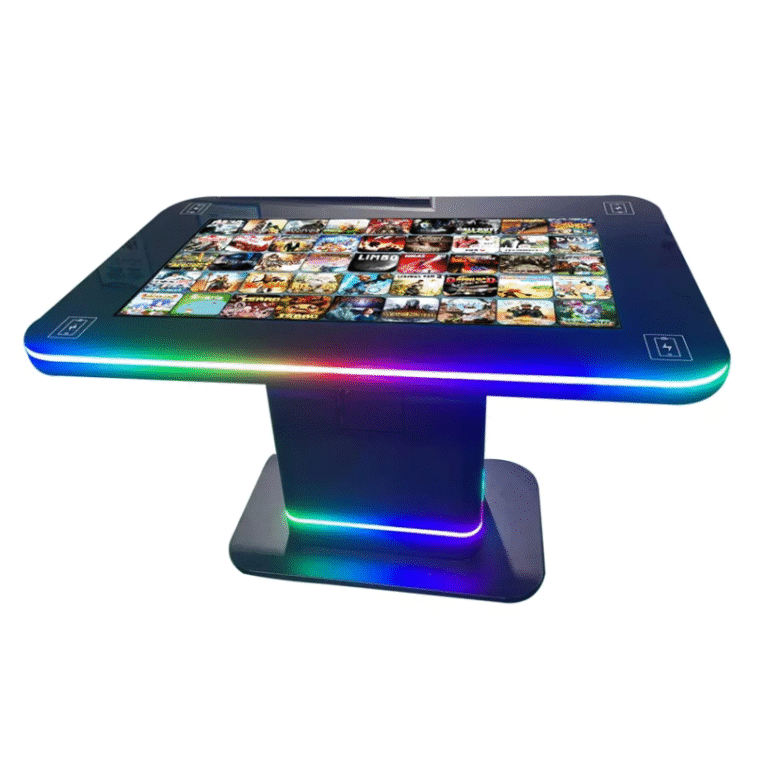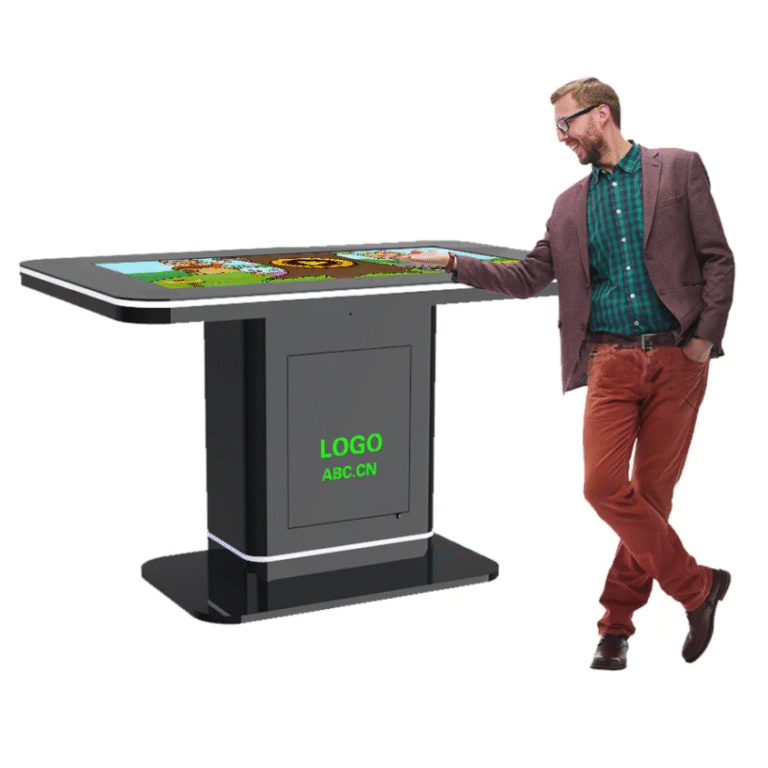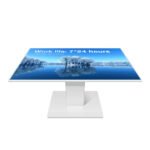Is a Table with Touch Screen the Future of Digital Signage?
The landscape of digital signage is perpetually evolving, moving beyond static screens and one-way communication to embrace deeper, more meaningful interactivity. At the heart of this transformation lies the integration of advanced display technology into everyday furniture, specifically the emergence of the table with touch screen. This isn’t merely a novelty; it represents a significant shift in how businesses, particularly those in retail, hospitality, and corporate environments, engage with their customers and manage internal operations. For digital signage product users, understanding the profound capabilities and strategic deployment of this technology is critical for maintaining a competitive edge and maximizing return on investment.
The Evolution and Essence of the Table with Touch Screen

Initially, digital signage focused predominantly on broadcasting information. Today, however, the emphasis has shifted towards creating immersive, two-way experiences. A table with touch screen seamlessly integrates a high-definition interactive display into a durable, functional piece of furniture. Unlike traditional vertical kiosks or wall-mounted displays, the horizontal format inherently encourages collaborative use and a more relaxed, natural interaction, mirroring the way people naturally gather around a table.
This technology is fundamentally designed to be robust and reliable. High-quality tables are typically built with toughened, scratch-resistant glass, often using industrial-grade components to withstand continuous, high-traffic use in public environments. Furthermore, they are generally equipped with multi-touch capabilities, allowing several users to interact simultaneously. This collaborative potential is perhaps its most distinguishing feature, setting it apart from single-user interactive kiosks. Consequently, businesses can move beyond simple information viewing to facilitate shared experiences, such as co-designing products or collaborative brainstorming.
Core Features That Define Its Value in Digital Signage
The appeal of the table with touch screen is rooted in its unique combination of features, all of which directly address the limitations of conventional digital signage solutions:
Unmatched Interactive Engagement and User Experience
The intuitive, direct manipulation offered by touch technology dramatically increases user engagement. Placing information or applications on a table format encourages users to sit down, linger, and spend more time interacting with the content. This extended dwell time is invaluable in retail environments, allowing customers to fully explore product catalogs, customize purchases, or compare specifications without the pressure of a sales associate. The experience is essentially self-guided discovery.
Seamless Integration into Physical Spaces
A significant advantage is the aesthetic and functional integration into a physical space. Unlike a large, imposing kiosk, a table with touch screen serves a dual purpose: it is a functional piece of furniture that also happens to be a powerful digital display. This blend of form and function makes it ideal for sophisticated environments like luxury showrooms, modern hotel lobbies, or executive lounges, where maintaining a clean, contemporary aesthetic is crucial. The tables often come in various designs and finishes, ensuring they complement the existing decor, thus avoiding the visual clutter associated with purely utilitarian hardware.
Durability and Environmental Resilience
Given their deployment in public areas, these tables are engineered for resilience. They are frequently designed to be spill-resistant, easy to clean, and capable of operating 24/7. This industrial-grade durability is a non-negotiable requirement for digital signage products, where equipment failure directly translates to missed opportunities. The robust construction ensures a long service life and reduced maintenance overhead, providing significant long-term value.
Strategic Applications in the Digital Signage Ecosystem

The deployment of a table with touch screen within the digital signage ecosystem is highly strategic, offering bespoke solutions across multiple industries:
In Retail and Showrooms: The table transforms the sales floor into an immersive, interactive point of sale. Customers can place a product on the table and have the screen instantly pull up specifications, reviews, and complementary items (often referred to as ‘object recognition’ technology). Furthermore, entire inventory databases can be made accessible, allowing customers to check stock levels or order out-of-stock items for home delivery, essentially creating an ‘endless aisle’ experience.
In Hospitality and Entertainment: In restaurants or bars, these tables can be used for digital menus, allowing patrons to browse visually rich food and drink options, place orders, and even pay directly. This not only streamlines the ordering process but also provides upselling opportunities through dynamic recommendations. In hotels, they serve as interactive concierge stations, offering local maps, booking excursions, or checking in/out. The collaborative nature of the touch table also lends itself perfectly to interactive games in waiting areas, effectively reducing perceived wait times.
In Corporate and Educational Settings: For corporate digital signage, the tables excel as sophisticated presentation tools or collaborative whiteboards in meeting rooms and collaborative spaces. Their horizontal orientation is ideal for group discussions, allowing multiple participants to annotate documents, manipulate 3D models, or share screens simultaneously. In educational institutions, they facilitate interactive learning modules and group assignments, moving away from passive instruction towards active, hands-on exploration.
Navigating Technical Considerations and Integration
For digital signage professionals, the successful integration of a table with touch screen hinges on several technical and operational considerations. Firstly, software compatibility is paramount. The chosen content management system (CMS) must fully support multi-touch and horizontal display orientation. The content itself needs to be specifically designed for a table format—optimizing touch targets, ensuring readability from various angles, and designing for simultaneous user inputs.
Secondly, network stability is crucial. Since these tables often process transactions or access cloud-based data, a reliable, secure network connection (be it wired or robust Wi-Fi) must be established. Moreover, proper power management, including the capability for remote monitoring and troubleshooting, is essential for maintaining uptime and optimizing operational efficiency.
Conclusion: A Catalyst for Experiential Signage
The table with touch screen is undoubtedly more than a technological fad; it is a foundational piece in the future of experiential digital signage. By moving the interaction from a detached, vertical screen to a communal, horizontal surface, it fundamentally changes the nature of customer engagement. It offers businesses the power to deliver personalized, collaborative, and memorable experiences, moving beyond simple information dissemination to true interaction and service delivery.
For savvy digital signage users and product providers, the focus must be on leveraging the table’s inherent strengths—its durability, its collaborative capability, and its seamless integration into functional spaces. By strategically implementing this technology, organizations can unlock new levels of efficiency and, more importantly, forge deeper, more valuable connections with their users. The question is no longer whether this technology is relevant, but rather how quickly organizations will embrace its transformative potential to redefine the customer journey.
Frequently Asked Questions (FAQ)
What is the typical lifespan of a table with touch screen in public use? High-quality, industrial-grade touch tables are specifically designed for demanding environments, often boasting a lifespan similar to commercial-grade digital displays, typically exceeding 50,000 operating hours. They are rigorously built to withstand continuous public use, including accidental spills and moderate impact, ensuring long-term reliable performance.
Can multiple users interact with the touch table simultaneously? Absolutely. A primary feature of professional-grade touch tables is their multi-touch capability. These units typically support anywhere from 10 to 40 simultaneous touch points, making them perfectly suited for collaborative projects, group browsing, and shared interactive experiences in public settings.
How is content managed and updated on a touch screen table? Content management for these devices is handled through standard Digital Signage Content Management Systems (CMS). These platforms are adapted to fully support touch interactions and horizontal display orientation. Content updates, new applications, and system maintenance are efficiently handled remotely, typically pushed over a secure internet connection, which allows for real-time changes across an entire fleet of installed tables.
Are these tables suitable for outdoor or semi-outdoor use? While most standard commercial models are optimized for indoor environments (such as retail interiors or corporate lobbies), specialized, higher-cost models are available. These feature weatherproof enclosures, enhanced thermal management systems, and high-brightness screens, making them suitable for protected semi-outdoor areas or demanding fully-outdoor applications where they must withstand the elements.




